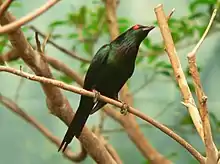| Aplonis | |
|---|---|
 | |
| Metallic starling (Aplonis metallica) | |
| Scientific classification | |
| Domain: | Eukaryota |
| Kingdom: | Animalia |
| Phylum: | Chordata |
| Class: | Aves |
| Order: | Passeriformes |
| Family: | Sturnidae |
| Genus: | Aplonis Gould, 1836 |
| Type species | |
| Aplonis fusca[1] Gould, 1836 | |
Aplonis is a genus of starlings. These are essentially island species of Indonesia and Oceania, although some species' ranges extend to the Malay Peninsula, southern Vietnam and northeastern Queensland. The typical adult Aplonis starling is fairly uniformly plumaged in black, brown or dark green, sometimes with a metallic gloss. The eye ring is often distinctively coloured. Immatures of several species have dark streaked pale underparts.
Several species have restricted ranges, and, like other island endemics, have become endangered or extinct as a result of habitat loss or introduced mammals such as rats.
Taxonomy
The genus Aplonis was introduced in 1836 by the English ornithologist John Gould.[2] He listed two species in the new genus but did not specify which was the type species. In 1840 George Gray designated the Aplonis fusca Gould 1836 as the type. This is the extinct Tasman starling.[3][4] The genus name is from Ancient Greek haploos meaning "simple" or "plain" and ornis meaning "bird".[5]
The genus Aplonis contains 25 species. Of these three have become extinct in historical times:[6]
- Metallic starling, Aplonis metallica
- Violet-hooded starling, Aplonis circumscripta
- Yellow-eyed starling, Aplonis mystacea
- Singing starling, Aplonis cantoroides
- Tanimbar starling, Aplonis crassa
- Atoll starling, Aplonis feadensis
- Rennell starling, Aplonis insularis
- Long-tailed starling, Aplonis magna
- White-eyed starling, Aplonis brunneicapillus
- Brown-winged starling, Aplonis grandis
- Makira starling, Aplonis dichroa
- Rusty-winged starling, Aplonis zelandica
- Striated starling, Aplonis striata
- † Tasman starling, Aplonis fusca (extinct c.1923)
- † Norfolk starling, Aplonis fusca fusca (extinct c.1923)
- † Lord Howe starling, Aplonis fusca hulliana (extinct c.1919)
- Mountain starling, Aplonis santovestris
- Asian glossy starling, Aplonis panayensis
- Moluccan starling, Aplonis mysolensis
- Short-tailed starling, Aplonis minor
- Micronesian starling, Aplonis opaca
- Pohnpei starling, Aplonis pelzelni (possibly extinct, c.2000)
- Polynesian starling, Aplonis tabuensis
- Samoan starling, Aplonis atrifusca
- † Kosrae starling, Aplonis corvina (extinct, mid-19th century)
- † Mauke starling, Aplonis mavornata (extinct, mid-19th century)
- Rarotonga starling, Aplonis cinerascens
An additional species is known only from fossils:
- Huahine starling, Aplonis diluvialis (prehistoric)
References
- ↑ "Sturnidae". aviansystematics.org. The Trust for Avian Systematics. Retrieved 2023-07-15.
- ↑ Gould, John (1837). "Aplonis". Proceedings of the Zoological Society of London. Part 4 (43): 73.
- ↑ Mayr, Ernst; Greenway, James C. Jr, eds. (1962). Check-list of Birds of the World. Vol. 15. Cambridge, Massachusetts: Museum of Comparative Zoology. p. 75.
- ↑ Gould, John (1837). "Aplonis". Proceedings of the Zoological Society of London. Part 4 (43): 73.
- ↑ Jobling, James A. (2010). The Helm Dictionary of Scientific Bird Names. London: Christopher Helm. p. 51. ISBN 978-1-4081-2501-4.
- ↑ Gill, Frank; Donsker, David; Rasmussen, Pamela, eds. (July 2023). "Nuthatches, Wallcreeper, treecreepers, mockingbirds, starlings, oxpeckers". IOC World Bird List Version 13.2. International Ornithologists' Union. Retrieved 13 August 2023.
- Feare, Chris; Craig, Adrian (1999). Starlings and Mynas. Princeton University Press. ISBN 0-7136-3961-X.